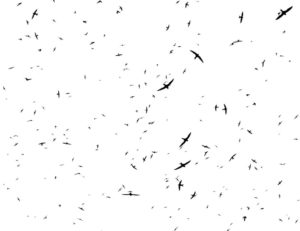If you’ve spotted a gray, cigar-shaped smudge floating through the air on a summer evening, then chances are that you’ve seen a chimney swift in flight. Chimney swifts are pretty amazing little birds, with small bodies  and a long, narrow wingspan. One thing that makes them unique is that they spend most of their time airborne. You may think that this applies to all birds, but chimney swifts are actually airborne for most of their lives, eating, drinking, and cleaning themselves in flight.
and a long, narrow wingspan. One thing that makes them unique is that they spend most of their time airborne. You may think that this applies to all birds, but chimney swifts are actually airborne for most of their lives, eating, drinking, and cleaning themselves in flight.
As for food, they eat many types of insects, including mosquitoes, ants, flies, and wasps. In fact, a family of chimney swifts can eat up to 12,000 insects every day. That’s a great bird to have in the area! They can’t perch, but instead have to cling vertically to surfaces during the few times that they do stop flying, which is while they are roosting or raising their young.
Swifts & Your Chimney
Chimney swifts migrate south to Peru each winter, then make their way up north in the spring to mate and to raise their families. Chimney swifts love company, and mainly travel in groups, but when it comes to mate they are monogamous.
Once swifts find a spot they like, they’ll return to it year after year. Here’s the thing, though – chimney swifts can’t perch. So, when they decide to roost, they have to find hollowed out trees or caves to build their nests. Now, in the early years of our country’s history, it wasn’t too much of a problem to find these spots year after year. Yet, as time passed and the country became more developed, these little birds had to look for another suitable nesting spot.
And what’s a better substitute for a hollow log or cave than a chimney? It’s tall, hollow, dark, warm, and free from predators – that checks off everything on their list!
Prevention
One problem with having a chimney swift set up a nest in your chimney is that the birds can make a lot of noise setting up their nest, and the babies can make a lot of noise once they are born. In fact, for a little bird, the noise level can be pretty amazing. For some people, this isn’t a bother at all, but for others, the noise is more than they want to put up with from year to year.
If you are one of those people who would rather not tolerate the noise of a chimney swift each spring, then it’s time to give Chimney Concepts a call.
Here’s the problem, though. Once swifts have set up camp, removing them is actually illegal, as they are federally protected. That means, you’re stuck with them until they leave on their own. Which they should do before cold weather really sets in, but it could be a nuisance in the meantime.
But while we can’t remove the birds while they are nesting, we can take precautions once they leave to make sure they can’t come back next year. After we clear your chimney of the swift’s nest and any other debris we find, we’ll fit your chimney with a chimney cap.
The main purpose of a chimney cap is to keep things out of your flue, so not only will you be protected from woodland critters, but you’ll minimize the risk of water damage, clogs, and other build-up, too. If yours is in a poor state of repair, or if you don’t have one installed at all, we’ll make sure to get one that is in top condition, so no critters, rain, or outside debris can find its way into your chimney anytime soon.
Ready to get started? Give us a call today!
